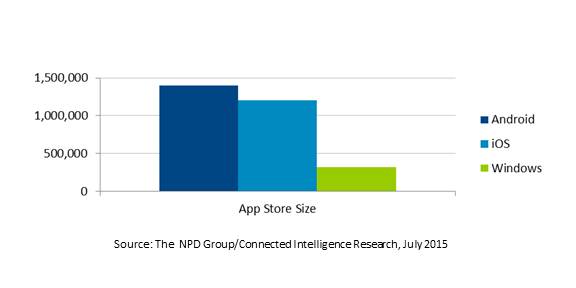Windows 10 launched with the key promise of creating a user experience that transcends the phone, tablet and PC. While this should, at least in theory, help drive the appeal of Windows-based phones, the reality is that it may be too little, too late for the mobile component. According to NPD’s Mobile Phone Track, Windows-based phones accounted for just 2.8 percent of U.S. smartphone sales in Q1 2015.
We live in a world dominated by Android and iOS – both hardware and apps. The Android and iOS platforms each offer more than one million apps but Microsoft is lacking apps and this remains their main challenge in offering a relevant third ecosystem choice for two reasons. Firstly, they are late to get new apps, being lower down in line for any developer; secondly, sometimes they are so low down that the app never comes. Think of last year’s key app, Flappy Birds. It came, got everyone hooked and vanished all without touching the Windows Phone world. And that is hardly a one-time issue: Windows Phone is lacking key apps in three top-tier categories; video, social, and gaming. In the video space, for example, Windows Phone has less than half the apps that can be found on Android and iOS, and both Amazon Instant Video and HBO GO missing.

In an effort to help boost app development, Microsoft recently launched the ability to more-easily port code from iOS over to the Windows platform. While a good step along the path, it is not necessarily the crux of the issue. Building an app is one thing; supporting it is quite another, and to justify the level of support needed (ensuring that it remains current with Android and iOS versions, for example) typically requires far more effort.
Microsoft’s greatest chance of gaining mobile users is converting them from its two biggest businesses - the PC and Xbox user bases. Xbox Live is built into Windows 10 and allows multi-player gaming across multiple platforms. Further, synergy between the PC environment and mobile has significant benefits within the work environment (think unified email and related communications) which can help to drive greater interest in the mobile platform. Time will be the only tell for Microsoft to know if the changes made to Windows 10 and its new cross-device development are enough to drive up phone adoption, which in turn could create a more competitive platform for developers to invest in.